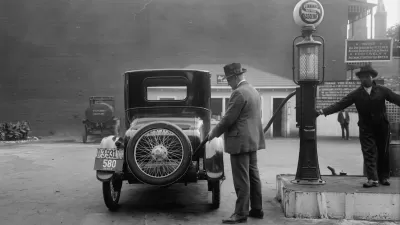Lucas Lindsey explores the rise and fall of gas stations in the U.S. With stations closing across the country, and cities wrestling with how to reclaim them, he looks at some that have found a new life through reuse, redevelopment, or repositioning.
The gas station has long been a mainstay of American urban form, but aggressive expansion during the U.S.’s post-war suburban boom effectively over positioned low-volume, small square footage stations throughout the country. Now the United States finds itself in the midst of a multi-decade decline in the number of gas station retailers. There’s a volatile mix of trends behind the steady evaporation of American gas stations—everything from market consolidation to tightening margins on retail sales. The forces at work are economically epic, structurally complex beasts beyond the remedy of any singular shift in market behavior or regulatory policy.
To a developer, a gas station’s highly specialized site layout and environmental risks make for an undesirable and needlessly complicated investment. As a result, many sit along the street boarded up and in disrepair. Forgotten, they are striking, even artistic, in what they symbolize: an old way of life in decline, but a decline that presents a possibility for change in values, purpose, and use.
Lindsey examines three strategies for finding new ways to use this specialized land use.
FULL STORY: Three Strategies for Refueling Abandoned Gas Stations

Study: Maui’s Plan to Convert Vacation Rentals to Long-Term Housing Could Cause Nearly $1 Billion Economic Loss
The plan would reduce visitor accommodation by 25,% resulting in 1,900 jobs lost.

Alabama: Trump Terminates Settlements for Black Communities Harmed By Raw Sewage
Trump deemed the landmark civil rights agreement “illegal DEI and environmental justice policy.”

Why Should We Subsidize Public Transportation?
Many public transit agencies face financial stress due to rising costs, declining fare revenue, and declining subsidies. Transit advocates must provide a strong business case for increasing public transit funding.

Paris Bike Boom Leads to Steep Drop in Air Pollution
The French city’s air quality has improved dramatically in the past 20 years, coinciding with a growth in cycling.

Why Housing Costs More to Build in California Than in Texas
Hard costs like labor and materials combined with ‘soft’ costs such as permitting make building in the San Francisco Bay Area almost three times as costly as in Texas cities.

San Diego County Sees a Rise in Urban Coyotes
San Diego County experiences a rise in urban coyotes, as sightings become prevalent throughout its urban neighbourhoods and surrounding areas.
Urban Design for Planners 1: Software Tools
This six-course series explores essential urban design concepts using open source software and equips planners with the tools they need to participate fully in the urban design process.
Planning for Universal Design
Learn the tools for implementing Universal Design in planning regulations.
Smith Gee Studio
Alamo Area Metropolitan Planning Organization
City of Santa Clarita
Institute for Housing and Urban Development Studies (IHS)
City of Grandview
Harvard GSD Executive Education
Toledo-Lucas County Plan Commissions
Salt Lake City
NYU Wagner Graduate School of Public Service





























